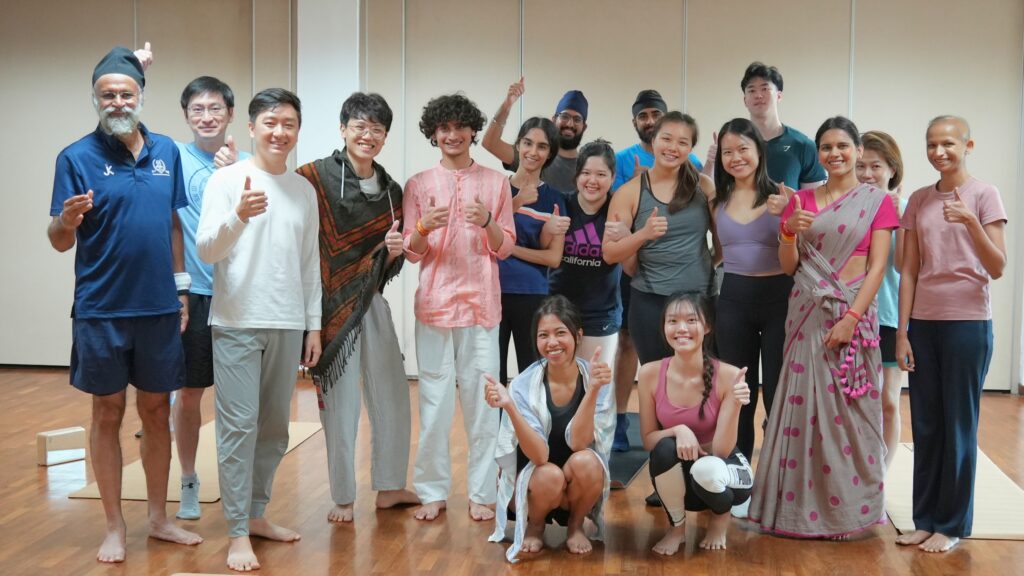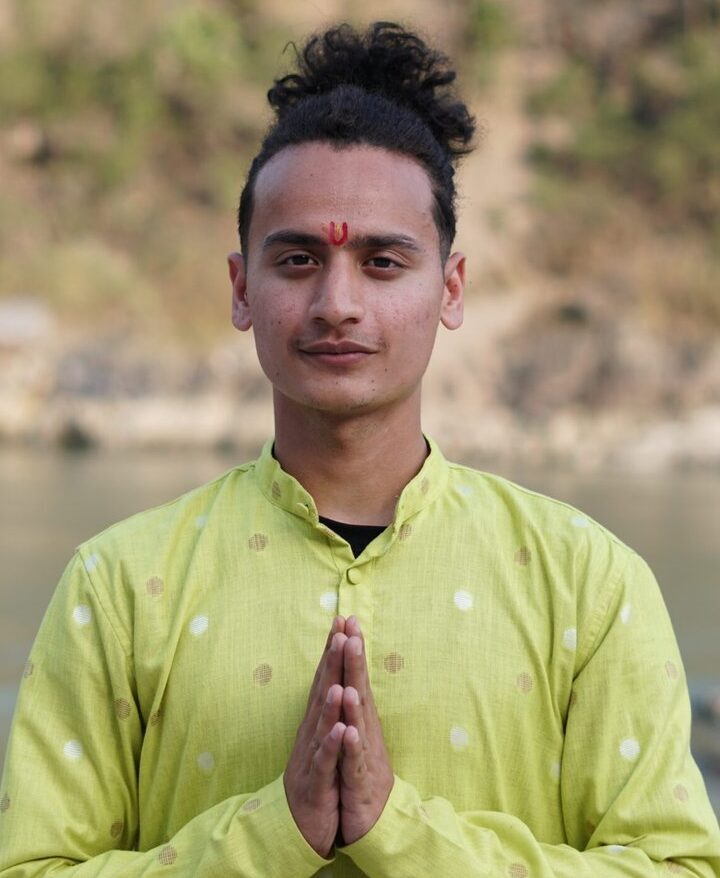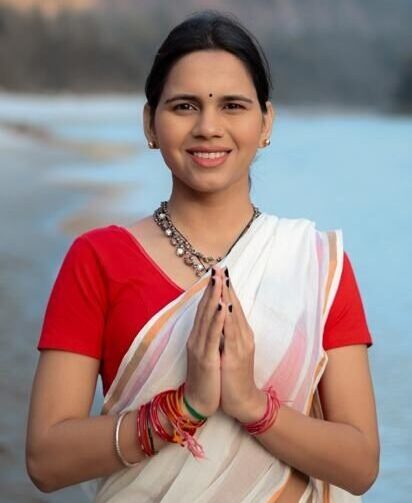300 Hour Yoga Teacher Training in Rishikesh, India
Become a certified Yoga teacher and take part in 28 day journey with Authentic Yoga Teacher Training in Yoga Capital of the World.

Why Join Us
Beautiful Location : Practice yoga in the spiritual heartland of India, where ancient wisdom meets natural beauty.
Certified Instructors: Learn from Yoga Alliance certified teachers who are rooted in authentic Indian traditions and have decades of teaching experience.
Yoga Alliance Accredited: Yoga Alliance Certified, advancing you to RYT500.
Holistic Curriculum: Our curriculum covers advance Hatha Yoga, Ashtanga Yoga, Pranayama, Meditation, Yoga Anatomy, Philosophy, and more, offering a comprehensive understanding of the practice.
- 28 Day / 27 Night of immersive learning in Rishikesh
- Multi Style Yoga : Advance Hatha, Vinyasa and Ashtanga
- Healthy and delicious Sattvic Meals
- English
- 300 Hour Yoga Teacher Training in Rishikesh

Daily Schedule
The 300 Hour Yoga Teacher Training daily schedule is carefully designed to integrate advanced yoga practice, in-depth theory sessions, and dedicated personal time for reflection and growth. This comprehensive approach supports a holistic learning experience, fostering both physical mastery and deeper spiritual understanding.
05:30
Wake Up
06:00 – 07:30
Mantra, Shatkarma & Pranayama
07:30 – 09:00
Hatha, Vinyasa Flow
09:00 – 10:00
Healthy Breakfast
10:00 – 11:00
Alignment, Adjustment, Teaching Methodology
11:00 – 12:00
Yoga & Anatomy Philosophy
12:00 – 13:00
Karma Yoga (Seva)
13:00 – 14:30
Lunch & Rest
14:30 – 16:00
Selfy Study & Self Practice
16:00- 16:15
16:30 – 18:00
Ashtanga Yoga
18:00 – 19:00
Relaxation & Meditation
19:00 – 20:00
Dinner
20:00
Rest Hours
300 Hour Teacher Training Syllabus
Advance your practice and teaching with our 300 Hour Teacher Training in Rishikesh. Deepen your skills and knowledge in an immersive, transformative experience.
300-Hour Yoga Teacher Training – Weekly Asana Breakdown
1st Week: Foundations of Hatha & Vinyasa Flow
- Introduction to Hatha & Vinyasa Flow
- Warm-Up & Basic Asanas:
- Pawanmuktasana Series A
- Surya Namaskar (Hatha)
- Chandra Namaskar (Hatha)
- Standing Poses:
- Trikonasana
- Parsvokonasana
- Privarta Trikonasana
- Privarta Parsvokonasana
- Virbhadrasana (A, B, C)
- Balancing & Core Poses:
- Ardha Chandrasana
- Chaturangadandasana
- Core Exercises
- Seated & Backbends:
- Mathchendrasana (A, B, C)
- Adra Ustrasana
- Salabhasana
- Setabandasana
- Forward Bends:
- Gatyatmak Paschimottasana
- Pada Prasar Paschimottasana
- Saithalyasana
- Sarvangasana
2nd Week: Intermediate Standing & Balancing Asanas
- Flow Sequences:
- Surya Namaskar (A, B) – Ashtanga
- Chandra Namaskar (Hatha)
- Standing Poses:
- Veerbhadrasana (A, B, C)
- Trikonasana
- Parsvottanasana
- Parsvokonasana
- Privirta Trikonasana
- Privirta Parsvokanasana
- Ardha Chandrasana
- Balancing Poses:
- Utthita Hasta Padangusthasana
- Natrajasana
- Vriksasana
- Garudasana
- Eka Pada Uttanasana
- Natavarasana
- Tandavasana
- Eka Padasana
- Vatayanasana
- Pada Angushtasana
- Arm Balances:
- Baka Dhyanasana
- Eka Pada Baka Dhyanasana
3rd Week: Advanced Arm Balances & Backbends
- Arm Balances:
- Eka Hasta Bhujasana
- Santolanasana
- Vashisthasana
- Twists & Backbends:
- Poorna Matsyendrasana
- Marichyasana (C, D)
- Eka Pada Rajakaputasana
- Raja Kaputasana
- Poorna Ustrasana
- Dhanurasana
- Poorna Shalabhbasana
- Poorna Chakrasana
- Seated & Forward Bends:
- Parighasana
- Koormasana
- Upavistakonasana
- Ubhaya Padangustasana
- Urdvamukha Paschimottasana
- Splits & Hip Openers:
- Hanumanasana
- Bhoonamansana
- Laguvajarasana
- Badhakonasana
- Vishwamitrasana
- Kashyapasana
Inverted Asanas: Integrated Throughout the Weeks
- Inversions:
- Bhumi Padamastakasana
- Vipreetakarani Asana
- Sarvangasana
- Padma Sarvangasana
- Halasana
- Ardha Padma Halasana
- Sirshasana
- Salamba Sirshasana
- Niralambasana
- Urdhwa Padmasana
- Leg Stretching
4th Week: Teaching Practice and Review
- Teaching Practicum: Guided practice teaching sessions with feedback
- Doubt Clearing: Dedicated time to clarify concepts and ask questions
- Q&A Sessions: Interactive sessions for further insights and knowledge sharing
Asana Categories for 300-Hour Yoga Teacher Training
Standing Postures
- Foundation & Warm-Up:
- Samasthiti
- Sun Salutation (A & B)
- Standing Forward Bends & Twists:
- Padangushtasana
- Pada Hastasana
- Utthita Trikonasana
- Parivritta Trikonasana
- Utthita Parsvakonasana
- Parivrtta Parsvakonasana
- Wide-Legged Forward Bends:
- Prasarita Padottanasana (A, B, C & D)
- Parsvottanasana
Intermediate Postures
- Twists & Hip Openers:
- Pasasana
- Krounchasana
- Bharadvajasana
- Ardha Matsyendrasana
- Gomukhasana (A, B, C)
- Backbends & Heart Openers:
- Shalabhasana (A, B)
- Bhekasana
- Dhanurasana
- Parsvadhanurasana
- Ustrasana
- Laghu Vajrasana
- Kapotasana
- Supta Vajrasana
- Arm Balances & Inversions:
- Bakasana
- Pincha Mayurasana
- Karandavasana
- Mayurasana
- Makarasana
- Leg-Behind-Head Poses:
- Ekapada Sirsasana (A, B, C)
- Dwipada Sirsasana (B)
- Yoga Nidrasana
- Advanced Flexibility Poses:
- Tittibhasana (A, B, C)
- Vatayanasana
- Parighasana
- Supta Urdhvapada Vajrasana (A, B)
- Inverted Headstands:
- Mukta Hasta Sirsasana (A, B, C)
- Baddha Hasta Sirsasana (A, B, C, D)
- Urdhva Dhanurasana
- Drop Back to Urdhva Dhanurasana
- Forward Bends:
- Paschimottanasana
Finishing Postures
- Shoulderstand Sequence:
- Salamba Sarvangasana
- Halasana
- Karnapidasana
- Urdhva Padmasana
- Pindasana
- Fish Pose Variations:
- Matsyasana
- Uttana Padasana
- Headstand Sequence:
- Shirshasana
- Baddha Padmasana
- Yoga Mudra Padmasana
- Final Balances & Relaxation:
- Uth Pluthi (Tolasana)
- Shavasana
Meditation Topics for 300-Hour Yoga Teacher Training
Understanding the Mind and Meditation
- What is the Mind and its Role in Meditation?
- Nature of the Mind: Why is the Mind Restless?
- What is Concentration?
- Difference Between Concentration and Meditation
- Fundamental Importance of Meditation
Types of Meditation Techniques
- Anapana Meditation
- Mahamrityunjaya Mantra Meditation
- Gayatri Mantra Meditation
- Om Mani Padme Hum Mantra Meditation
- Yoga Nidra Meditation
- Vipassana Meditation
- Sound Healing Therapy for Chakras
Exploring Chakra Meditation and Pranic Energy
- Introduction to the 7 Chakras, Aura, and Prana
- Mantras for Chakra Meditation:
- Muladhara Chakra
- Swadhisthana Chakra
- Manipura Chakra
- Anahata Chakra
- Vishuddhi Chakra
Dynamic and Movement-Based Meditation Practices
- Dynamic Moving Meditation (Osho)
- Kirtan Spiritual Dancing Meditation
- Walking Meditation
- Self-Surrender Meditation
- Jyoti Tratak Meditation
Advanced Concepts in Meditation
- What is Samadhi?: Understanding the Process of Samadhi
Ayurveda Fundamentals and Therapeutic Applications
Introduction to Ayurveda
- Concept and Fundamentals of Ayurveda
- Meaning, Definition, and Principles of Ayurveda
Core Concepts of Ayurveda
- Tridosha: Meaning and Functions
- Agni: Types and Functions
- Ama: Meaning and Types
- Trimalas: Types and Relation with Tridosha
- Triguna: Importance and Attributes
- Fundamental Relation of Triguna with Tridosha
- Saptprakarti: Attributes and Qualities
- General Functions and Characteristics of Saptprakarti
Diet and Nutrition in Ayurveda
- Mithahara: Definition and Meaning
- Fundamentals and Importance of a Sattvic Diet
- Categories of Food and Their Explanation
- Diet According to the Position of the Sun
- Saptprakarti and Tridosha Diet
Therapeutic Applications of Ayurveda
- Dietary Needs and Therapies:
- Therapy and Dietary Needs for Arthritis
- Osteoporosis Treatment and Therapy
- Sinusitis Therapeutic Cure
- Irritable Bowel Syndrome Therapy
- Therapy for Constipation Problems
- Therapeutic Use of Asanas:
- For Disc Herniation
- For Back Problems
- Respiratory and Digestive System Treatments:
- Asthma’s Problematic Area and Cure
- Therapeutic Use of Meditation for Depression
- Therapeutic Use of Pranayama for Anxiety Disorders
- Therapeutic Use of Shatkarmas for Migraine
- Therapeutic Use of Pranayama for Amnesia Disorder
Course Completion and Evaluation
- Assignment Submission
- Review and Revision
- Practical Exam: Presentation on Selected Topic
Weekly Breakdown
Week 1: Advanced Pranayama Practices
- Introduction to various pranayama techniques, focusing on developing a strong foundation and control over breath.
Week 2: Variations and Experiments
- Exploring different pranayama variations and adapting practices to individual needs.
Week 3: Awakening Nadis and Chakras
- Techniques for clearing nadis (energy channels) and activating chakras through specific pranayama practices.
Week 4: Teaching Practices and Mastery of Breathing
- Emphasis on teaching skills, refining techniques, and mastering pranayama practices to effectively guide others.
Core Concepts and Theoretical Topics
- Introduction to Pranayama:
- What is Pranayama?
- How Pranayama Brings Happiness
- Physiology of Prana
- Elements in the Nature of Prana
- Prana Body Types
- Astrology and the Science of Breathing
- Understanding Prana:
- Prana and Its Routes
- How Prana Flows in the Body
- Prana & Consciousness
- Number of Breaths We Take
- Research on Prana
- Health Parameters and Breath Length
- Guidelines and Discipline of Pranayama
Intermediate and Advanced Pranayama Techniques
- Upper Body Breathing:
- Clavicular Pranayama (Upper Chest Pranayama)
- Thoracic Pranayama (Middle Chest Pranayama)
- Koshtiya (Diaphragmatic Pranayama)
- Full Body Practices:
- Full Body Yogic Pranayama
- Pranava Pranayama (Om Meditation Breathing)
- Nadi Shodhana and Cleansing Techniques:
- Nadi Shodhana Pranayama (Anulom Vilom Pranayama)
- Bhastrika Pranayama (Bellows Breath)
- Kapalbhati Pranayama (Skull Shining Breath)
- Sound-Based Breathing:
- Bhramari Pranayama (Humming Bee Breath)
- Ujjayi Pranayama (Ocean Breath)
- Cooling and Calming Practices:
- Sitali Pranayama (Cooling Breath)
- Sitkari Pranayama (Hissing Breath)
- Murcha Pranayama (Swooning Breath Yoga)
- Nostril Breathing Techniques:
- Surya Bhedi Pranayama (Right Nostril Breathing)
- Chandra Bhedi Pranayama (Left Nostril Breathing)
Patanjali Yoga Sutras – Chapter Overview
Chapter 1: Yoga Samadhi
- Focus on the path to enlightenment through concentration and mental clarity.
- Key Sutras cover the nature of the mind, the importance of focus, and the stages of Samadhi.
Chapter 2: Yoga Sadhana
- Emphasis on spiritual practice and discipline.
- Key Sutras discuss the Eight Limbs of Yoga (Ashtanga Yoga), including ethical principles (Yamas and Niyamas), physical practice, and control of the breath.
Chapter 3: Yoga Vibhuti
- Exploration of the powers and accomplishments attained through advanced practice.
- Key Sutras describe the supernatural abilities (Siddhis) that arise from meditation and mastery over the senses.
Chapter 4: Yoga Kaivalya
- The ultimate goal of yoga: liberation and freedom (Kaivalya).
- Key Sutras focus on the nature of the soul, freedom from the cycle of birth and death, and achieving ultimate spiritual liberation.
Yoga Anatomy & Physiology Module Overview
1st Week: Introduction to Key Body Systems
- Skeletal System: Overview of structure and functions
- Shoulder Anatomy: Key muscles and their roles
- Pelvic Girdle Anatomy: Muscles and functional importance
- Spinal Anatomy: Structure, function, and significance in yoga
- Kundalini Shakti: Introduction and functions
- Chakras and Endocrine System: Basic functions and connections
- Nadis: Energy channels, function, and importance in yoga
- Prana: Introduction and its role in organ function
- Panchakosha: Importance in overall body function
2nd Week: Advanced Energy Concepts
- Chakras and Endocrine System: In-depth exploration of functions
- Nadis: Further insights into their roles as energy pathways
- Prana: Advanced understanding of prana’s impact on organ health
- Panchakosha: Deeper look into the five layers of human existence
3rd Week: Major Body Systems and Their Health
- Respiratory System: Functions, importance, and common issues
- Circulatory System: Role in overall health, functionality, and potential problems
- Digestive System: Functions, impact on health, and common disorders
- Assignment Submission & Revision: Review and clarify concepts covered
4th Week: Evaluation and Assessment
- Practical Exam: Student presentations for hands-on evaluation
- Written Exam: Submission of final assignment for assessment
Shatkarmas (Yogic Cleansing Techniques)
- Introduction to Shatkarma: Purpose and benefits of cleansing practices
- Jalaneti Satkarma: Nasal cleansing with salty water
- Rubber Neti: Nasal cleansing using a rubber string
- Kunjal Kriya: Stomach cleansing technique
- Shankh Prakshalan Kriya: Intestinal cleansing method
Bandhas (Energy Locks)
- Introduction to Bandhas: Purpose and significance in yoga practice
- Jalandhara Bandha: Throat lock and its effects
- Moola Bandha: Root lock for grounding energy
- Uddiyana Bandha: Abdominal lock and its benefits
- Maha Bandha: Combining all three locks for energy flow
Mudras (Yoga Gestures)
- Introduction to Mudras: Overview and importance of yoga gestures
- Fundamental Importance of Mudras: How mudras influence energy and mind
- Key Mudras:
- Jnana Mudra: Gesture of knowledge
- Vayu Mudra: Gesture for balancing air element
- Bhairava Mudra: Symbolizing masculine energy
- Pranav Mudra: Gesture for life force
- Sankhmukhi Mudra: Gesture for withdrawal of senses
Asana Categories for 300-Hour Yoga Teacher Training
Standing Postures
- Foundational Standing Poses:
- Samasthiti
- Sun Salutation (A & B)
- Forward Bends and Twists:
- Padangushtasana
- Pada Hastasana
- Utthita Trikonasana
- Parivritta Trikonasana
- Utthita Parsvakonasana
- Parivrtta Parsvakonasana
- Prasarita Padottanasana (A, B, C & D)
- Parsvottanasana
Intermediate Postures
- Twists and Hip Openers:
- Pasasana
- Krounchasana
- Bharadvajasana
- Ardha Matsyendrasana
- Backbends and Heart Openers:
- Shalabhasana (A, B)
- Bhekasana
- Dhanurasana
- Parsvadhanurasana
- Ustrasana
- Laghu Vajrasana
- Kapotasana
- Supta Vajrasana
- Arm Balances and Leg-Behind-Head Poses:
- Bakasana
- Ekapada Sirsasana (A, B, C)
- Dwipada Sirsasana (B)
- Yoga Nidrasana
- Tittibhasana (A, B, C)
- Advanced Balances and Inversions:
- Pincha Mayurasana
- Karandavasana
- Mayurasana
- Makarasana
- Vatayanasana
- Parighasana
- Gomukhasana (A, B, C)
- Supta Urdhvapada Vajrasana (A, B)
- Mukta Hasta Sirsasana (A, B, C)
- Baddha Hasta Sirsasana (A, B, C, D)
- Urdhva Dhanurasana
- Drop Back to Urdhva Dhanurasana
- Forward Bends:
- Paschimottanasana
Finishing Postures
- Shoulderstand and Plow Sequence:
- Salamba Sarvangasana
- Halasana
- Karnapidasana
- Lotus and Headstand Variations:
- Urdhva Padmasana
- Pindasana
- Shirshasana
- Baddha Padmasana
- Yoga Mudra Padmasana
- Relaxation and Grounding:
- Matsyasana
- Uttana Padasana
- Uth Pluthi (Tolasana)
- Shavasana
Teaching Methodology Components
- Demonstration & Teaching Techniques: Key approaches to effectively demonstrate asanas and guide students.
- Alignment: Focus on proper body alignment to ensure safety and maximize benefits.
- Instructions: Clear and concise verbal cues to enhance understanding and execution of postures.
Evaluation Criteria
- Written Test: Assessment of theoretical knowledge on yoga concepts and principles.
- Asana Practical Test: Evaluation based on proficiency and technique in asana practice.
- Attendance: Consistent participation and commitment throughout the training.
- Performance: Overall skill development, including improvements in flexibility, strength, and technique.
- Behavior: Professionalism, attitude, and interactions within the class environment.
Stay at Himalayan Retreat Centre, Rishikesh
your dates is free and easy. Indian students please connect with our booking team for Indian Students Pricing at +91 78955 62586 and +91 63988 13126
Non-residential
International Students
-
200 Hrs training and all group events
-
Sattvic food ( Breakfast, Lunch & Dinner)
-
Yoga Mat & Study Materials
-
1 Ayurvedic Massage
-
Sunday Excursion
-
Cooking Classes
-
1 Sound Healing Session
-
Indian Classical Music Session
-
Detox water
Twin bed room
International Students
-
Two single beds
-
200 Hrs training and all group events
-
Airport Transfer
-
Sattvic food ( Breakfast, Lunch & Dinner)
-
Yoga Mat & Study Materials
-
Ac Room/ Free Wi-Fi
-
1 Ayurvedic Massage
-
Sunday Excursion
-
Cooking Classes
-
1 Sound Healing Session
-
Indian Classical Music Session
-
Detox water
Private room
International Students
-
Single bed
-
200 Hrs training and all group events
-
Airport Transfer
-
Sattvic food ( Breakfast, Lunch & Dinner)
-
Yoga Mat & Study Materials
-
Ac Room/ Free Wi-Fi
-
1 Ayurvedic Massage
-
Sunday Excursion
-
Cooking Classes
-
1 Sound Healing Session
-
Indian Classical Music Session
-
Detox water
Teachers
Our Teachers Rooted in Authentic Yoga Practices

Sachin Ji hails from Devprayag, the sacred confluence where Mother Ganga originates, and brings a profound passion for yoga. With over five years of experience, he has imparted his knowledge at esteemed institutions in Rishikesh, including Rishikesh YTTC and 7 Chakra Yoga School. Qualifications Sachin holds multiple certifications and a formal academic background in yoga: YTTC Certifications: 200-hour and 300-hour

Hailing from Vrindavan, Shivani is deeply connected to Sanatan philosophy. Her upbringing in this sacred town has greatly influenced her spiritual journey. Following her heart, she embraced spiritual and social work with a focus on divine love. Shivani is involved in: Sanskrit Gurukul: Offering education, food, and accommodation to 300 students. Poojya Mata Shri Kishori Ji Sewa Trust: Engaging in projects for cow and animal welfare. Future Plans: Working on establishing a Gurukul in Ayodhya Ji to blend modern and traditional education.

